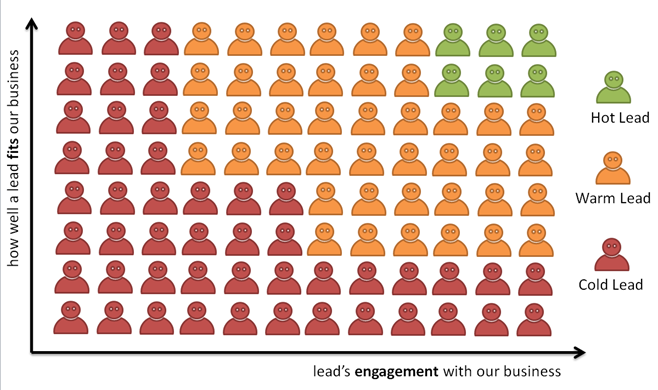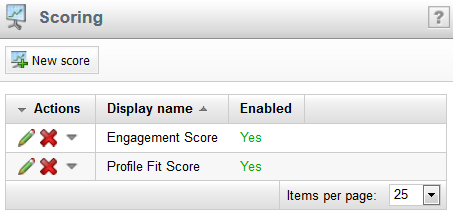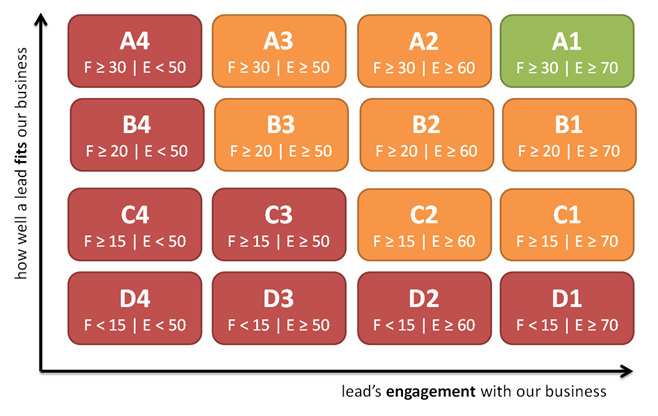How do We Score Your Visit to Our Website? Our Real Life Example of Lead Scoring in B2B Environment
The success of implementing lead scoring to your website lies in the setting up and fine tuning of the scoring rules. Be inspired by ours!
Quickly jump to:
-
Introduction to two-dimensional lead scoring
-
Setting Up lead scoring rules
-
List of Explicit (demographic) scores
-
List of Implicit (behavior based) scores
-
List of Bad Implicit (behavior based) scores
-
Creating lead scoring labels
-
Evaluating lead scoring strategy
Understanding Two-Dimensional Lead Scoring
Lead scoring is an automated way of qualifying and segmenting leads (i.e. potential sales contacts) on your website. In other words, it’s a method shared by marketing and sales teams for determining the
sales-readiness of leads. Having a lead-scoring system in place is the first step to quickly targeting and contacting leads closest to sale, further nurturing those not yet ready, and abandoning the rest.
In lead scoring, your site visitors are first scored according their activities on your website that reflect their engagement with your offer. This is then combined with points attributed based on their demographic data, such as geographical location, industry sector, or job title. This two-dimensional approach clearly reveals not just how well the leads
engage with your business, but how well they
fit into it, too.

These two dimensions are invaluable to avoid wasting time on leads (that have a high score, but no real interest in purchasing), and lost opportunities (on leads with a low score, but who are very interested in making a purchase). For example, a student working on his homework about your industry may spend hours on your website—reading your materials, watching your videos, and downloading brochures. This accrues him a very high score for engagement. But, in this two-dimensional approach to scoring, his demographic data wins him very few (or perhaps even negative) points for his fit into your business, meaning that his information is not passed to sales, so they can focus on real leads. To be processed by sales, leads must meet a certain score level in both dimensions.
Watch
an introduction video to Lead Scoring for a better understanding of two-dimensional lead scoring systems.
Setting Up Lead Scoring Rules
Searching the internet, you are likely to find a list of 200+ scoring rules to consider. In this blog post we’ll provide you with the
top 33 rules, proven to be effective for us on our main website:
Kentico.com.
We use the powerful
lead scoring feature of
Kentico EMS as a key customer data and engagement analytics tool to segment site visitors and follow up with them accordingly. We use the two-dimensional system of scoring both engagement and fit to business on separate scales.

Explicit (Demographic) Scores Show How Well the Leads Fit Our Business
Explicit scores are highly dependent on
data submitted to you by your site visitors. You may also acquire such data from 3rd party online directories of companies and business professionals. But our experience is that only a small portion of information gathered on the website will match (and can be paired with) the databases of these 3rd party services. Furthermore, even the successfully matched data is not always accurate.
So, the value of your explicit scoring is based on the richness of your website form fields, the willingness of visitors to complete them, and how honest they are when they do. However, the more fields there are in a form, the lower the response rate. So you have a balancing act to gather the most potent information in the smallest number of fields, having to make a compromise -
amount of information vs. response rate.
In our case, we have only three mandatory fields - First name, Last Name, and E-mail - and two optional fields - Company and Phone.
|
Explicit Data - Demographic Scores |
|
Rule Name |
Points |
Notes |
|
Phone Number |
10 |
This is an optional field; points are given for completion. |
|
Company Name |
5 |
This is an optional field; points are given for completion. |
|
Company Email Address |
5 |
E-mail is a mandatory field in all forms; points are given if email entered is not a free email address (as compared to our own list of known free email providers ) This might be the object of debate as many evaluators use free emails to download software in order to keep their company email SPAM-free. |
|
Country |
0-10 |
The majority of forms on our website don’t include this field; we use the geo-location service built in to Kentico CMS to select the country based on visitor IP address. |
In the future, we could consider adding the following fields to enhance the scoring, but with an expected drop in conversion rate:
-
Visitor’s job title/type
-
Visitor’s company size/type
-
Industry of the visitor’s company
-
Available budget of the visitor’s company
-
Annual revenue of the visitor’s company
Implicit (Behavior Based) Scores Show How Well the Lead Engages with Your Business
The following table shows 25 scores that are based solely on the behavior of the lead or their source of traffic:
|
Implicit Data - Behaviour Scores |
|
Implicit Data - Traffic Sources |
|
Rule Name |
Points |
Notes |
|
Traffic source - Direct |
5 |
Anyone typing the URL of our website. We assume these visitors have previously heard of us by recommendation (WOM) or an offline campaign. |
|
Traffic source - External Search |
2 |
A person searching for a solution is considered to be more interested. |
|
Traffic source - External Search inc. "kentico" |
3 |
A person searching for a solution who already knows our brand is considered to be even more interested. |
|
PPC Search Network Campaigns |
5 |
PPC Campaigns in Search Networks bring people searching for a particular solution. We do these campaigns also for brand keywords. Wonder why? |
|
Implicit Data - Behaviour at Website |
|
Rule Name |
Points |
Notes |
|
Number of Visits to Website |
4 |
The same number of points are given for a visitor’s 2nd, 3rd, 4th and 5th visits to the website. |
|
Number of Page Views |
6 |
Number of page views reaches 10. |
|
Number of Page Views |
8 |
Number of page views reaches 20. |
|
Number of Page Views |
4 |
Number of page views reaches 30. |
|
Number of Page Views |
4 |
Number of page views reaches 40. |
|
Visit to the "Purchase" Page |
10 |
Visit page "Purchase"; activity is scored only once. |
|
Visit to the "Order" Page |
25 |
Visiting page "Order"; activity is scored only once. |
|
Download of Assets |
10 |
Download of any asset such as a whitepaper, eBook, Brochure, Report, etc. Each asset is scored extra; recurring download of same asset is not scored. |
|
Internal Search |
2 |
Any search done on our website. The idea behind this is that some visitors might skip browsing 10 additional pages and use the search feature instead. Also, this activity is the most suitable for sales to build highly personalized answers. |
|
Kentico Newsletter Subscription |
10 |
Subscription to Kentico Newsletter. |
|
Lead Nurturing Email Click |
5 |
Clicking on any link within any of our lead-nurturing emails. Only one click per email is counted. |
|
Video Play |
1 |
Each time visitor plays a video - each video scored only once. |
|
Implicit Data - Evaluation Tools of the Product |
|
Rule Name |
Points |
Notes |
|
Personal Demo Registration |
15 |
Registration for an online 1-on-1 personal demo. |
|
Hosted Trial Request |
15 |
Request for our Hosted Trial service. |
|
Hosted Trial Actual Usage |
15 |
Login to Hosted Trial = actual use of the service. |
|
Download Trial Version |
15 |
Download of Trial version. |
|
Download Free Edition |
3 |
Download of Free edition. |
|
Install of Trial or Free Edition |
15 |
Install of either Trial or Free version finished. |
|
WWAG Installation |
10 |
Installation of Kentico CMS via Windows Web Application Gallery. |
|
Webinar Registration |
15 |
Registration for a Webinar. |
|
Webinar Attendance |
10 |
Attendance at a Webinar. |
|
Become a Partner |
15 |
Request for more information on the Partner Program. |
|
Partner Registration |
10 |
Registration to the Partner Program. |
|
Training Requests |
15 |
Request for Training services. |
|
DotNetGroupSite |
5 |
Registration of a .NET User Group. |
We were also considering to add these rules:
-
Time spent on the website
-
Purchase is not the exit page - In other words, visitor keeps browsing the site after seeing the pricing
-
Additional points for visits after period longer than X
Bad Implicit (Behavior Based) Scores
Although we currently don’t use any of them ourselves, a blog post on lead scoring rules wouldn’t be complete without mentioning negative scoring.
Here are some worth considering:
-
No website activity for a long period of time
-
Email unsubscribe
-
Not visiting a product or pricing page
-
Non-commercial interest
-
Visiting the Careers Area
-
Visiting the Press Area
-
Downloading the Free Edition
Creating Lead Scoring Labels
Clearly communicating a lead scoring system is crucial towards aligning the efforts of marketing & sales. Prior to setting up the scoring labels, there must be a common definition of all the terms used within the company, such as “visitor”, “lead”, “hot lead”, etc.
At Kentico, we are currently using three labels (groups) of leads:
-
Hot Lead – sales-ready leads that require a quick response from Sales
-
Warm Lead – leads with medium sales-readiness that need to be further nurtured
-
Cold Lead – leads with even lower sales-readiness that need nurturing from an earlier stage in the buying process

To be placed in a group, the lead must meet a certain score level in both dimensions – “
engagement” and “
fit to business”. The x axis of the following chart represents the level of engagement, while the y axis represents how well the lead fits the business.

Hot leads are all leads in group A1 (green color).
Warm leads are those in groups: A2, B1, C1, B2, A3, C2, B3 (orange color).
Cold leads are those in groups: C3, C4, B4, A4, D1, D2, D3, D4 (red color).

The points required for each group that represent how well a
lead fits our business (y axis) are below and have a maximum possible point level of 35:
To reach group A >= 30pts. To reach group B >= 20pts. To reach group C >=15pts. To reach group D < 15pts.
As you can see, we set up pretty strict rules in this dimension—a loss of more than 5 points removes a lead from group A. This ensures that a lead without a valid phone number—a loss of 10 points in our scoring system—could never be labeled a hot lead. Whereas a lead not supplying a company e-mail address, but only a free one—a loss of 5 points in our system rules—would still be considered a hot lead if all other rules are met.
The points required for each group that represent a
lead’s engagement with our business (x axis) are below. There is no given maximum (as some of the activities can be scored repeatedly):
To reach group 1 >= 70pts. To reach group 2 >= 60pts. To reach group 3 >= 50pts. To reach group 4 < 50pts.
In practice, any emerging hot lead is contacted ASAP by the sales team, while warm leads are processed on the fly, being prioritized according to their scores. Simultaneously, warm and cold leads are nurtured by the Marketing Automation feature of Kentico EMS to become hot and sales-ready. But that’s a whole different story - see how to
nurture leads using Marketing Automation.
Steps after the Successful Implementation of Lead Scoring
The implementation of lead scoring should initiate an
ongoing and constructive discussion between marketing and sales that helps each better understand the needs of the other in achieving their common goals.
-
All implemented rules should be under constant analysis for relevance and effectiveness in terms of points assigned to them.
-
A deeper analysis of won and lost opportunities might be conducted on a regular basis to reveal weak points or false hypotheses employed in the initial implementation or latest iteration of the lead scoring system.
Where to go next?
Are we missing any key scores? Is there anything wrong with the current ones? How do you score your site visitors? Let us know in the comments below!